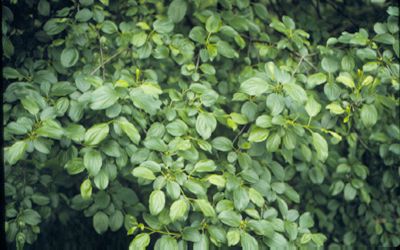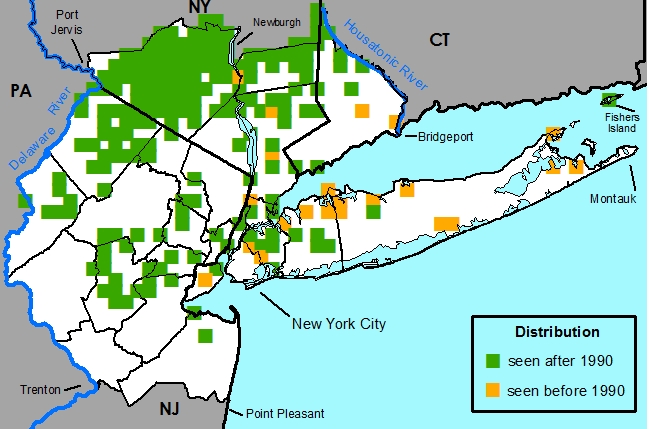Rhamnus cathartica L. - Common Buckthorn


Common Names
Common BuckthornField Identification
Large upright shrub with mostly opposite to sub-opposite finely-toothed leaves and dark-blue to black globose berries.Medicinal uses
Disclaimer: The information provided here is for reference and historical use. We do not recommend nor do we condone the use of this species for medicinal purposes without first consulting a physician.
The Cherokee used this species for skin irritation and as a mouth wash.
Other uses
Brizicky,1964 (Rehder, 1940) (Flint, 1983)This species is occasionally used in landscape plantings and is hardy to USDA zone 2-3.
Poisonous properties
Ingestion of fruits or leaves can cause mild to moderate nausea, vomiting, and diarrhea; death is unlikely.
Stories
This species is an alternate host to the crown rust disease of oats, it should be avoided or eradicated in areas where oats are grown; this and other Rhamnus species are prohibited by quarantine laws from many areas where oats are grown, especially in Canada.
Nomenclature
Rhamnus cathartica L., Sp. Pl. 193. 1753, “catharticus”.Rhamnus spinosa Gilib., Fl. Lit. Inch. 2: 132. 1782.
Cervispina cathartica Moench, Methodus 686. 1794.
Rhamnus Wikkor Luce, Topogr. Nachr. Oesel, 62. 1823.
Rhamnus Wicklia Ten., Cat. Orto Bot. Napoli, 95. 1845.
Rhamnus Willdenowiana Hort. ex K. Koch, Dendrologie 1: 605. 1869, pro. syn.; not Roem. & Schult., 1819.
TYPE: unknown
Description
HABIT Perennial, deciduous, phanerophytic, small tree or shrub, diclinous and dioecious, 1-6 m tall.STEMS Main stems erect, round. Bark smooth, brown or gray, not exfoliating. Branches erect or ascending. Twigs brown or gray, not odoriferous, terete, 2-5 mm in diam., smooth or warty, glabrous, eglandular. Pith white, round, continuous, nodal diaphragm absent. Thorns present, needle-like, 3-10 mm long, often on twig ends. Sap translucent.
BUDS Terminal and axillary present, monomorphic, scattered along stem; 3-5 mm long, pointed; axillary buds 1 per axil, 3-5 mm long, blunt. Dark brown, imbricate, membranaceous, glabrous, eglandular, margins ciliate. Bud scale scars not encircling the stem, often elevated.
LEAVES Subopposite to opposite, some alternate, simple, spiral, 1-2 per node, spaced somewhat evenly along and divergent from stem. Stipules present, lateral, deciduous, scale-like, minute. Leaves petiolate, petiole terete, 0.7-2.5 cm long, glabrous or with long and unbranched erect or spreading hairs, sparsely distributed throughout, glabrescent, eglandular. Leaf blades: elliptic or oblong or widely elliptic, bilaterally symmetric, 2-6 cm long, 1.5-3.5 cm wide, membranaceous, base acute or obtuse, margin toothed, serrulate, teeth often ending in minute, red-orange glands. Apex acuminate or cuspidate or obtuse. Abaxial surface light yellowish green, glabrous or with long and unbranched white hairs, sparsely distributed along midveins, glabrescent, eglandular. Adaxial surface green, glabrous, eglandular. Venation arcuate. For a review of the anatomy of the leaves see Gemoll, 1902,Herzog, 1903 (in German).
INFLORESCENCES Unisexual, simple or compound, consisting of a single flower or fascicle, axillary. Peduncle 0.6-1 cm long, glabrous. Pedicels 6-10 mm long, glabrous, eglandular.
FEMALE FLOWERS Coetaneous, with sepals and petals readily distinguishable from one another, 4-merous, perianth of two whorls, fragrance absent. Calyx actinomorphic, of free sepals, deciduous. Sepals 4, narrowly triangular, margin entire, apex acute, abaxial surface glabrous, eglandular, adnate to top of hypanthium. Corolla actinomorphic, of free petals, deciduous. Petals 4, lanceolate, 0.6 mm long, margins entire, abaxial surface glabrous, eglandular, adnate to top of hypanthium. Gynoecium syncarpous. Styles 4-forked. Ovary superior, glabrous, nectiferous disk present. Placentation basal. Androecium minute, with 4 sterile stamens.
MALE FLOWERS Fascicled, axillary. Pedicel 4-9 mm long, glabrous, eglandular. Perianth of two whorls. Calyx actinomorphic, of free sepals, deciduous, abaxial and adaxial surfaces yellowish green or green. Sepals 4, narrowly triangular, margin entire, apex acute, glabrous, eglandular, adnate to top of hypanthium. Corolla actinomorphic, of free petals, light yellowish green or white, petals 4, 1- 1.3 mm long, margin entire, apex obtuse, eglandular, adnate to top of hypanthium. Stamens 4, yellow, glabrous, eglandular, filaments free. Gynoecium vestigial. For a review of the morphology of the petals and pollen see Bennek,1958(in German).
FRUITS Drupe, black, ovoid, 5-8 mm long, 5-8 mm wide, glabrous, eglandular, glossy.
SEEDS Seeds 4, brown or dark yellowish green, 5-6 mm long, 3-4 mm wide, glabrous, eglandular, smooth, trigonus in cross-section.
Habitat
Moist to mesic roadsides, fields, thickets, and woods; occasionally in dryer situations.Distribution
Indigenous to Europe, western and northern Asia; now naturalized in the northern United States and adjacent Canada.United States -- CA, CO, CT, DE, IA, IL, IN, KS, MA, MD?, ME, MI, MN, MO, MT, ND, NE, NH, NJ, NY, OH, PA, RI, SD, UT, VA, VT, WI, WV?, WY
Canada -- MB, NB, NS, ON, PE, QC, SK
New York Metropolitan Region -- Nonnative, distributed throughout the metropolitan area, especially inland.
Rarity Status
Heritage global rank -- G5Species Biology
FloweringMay [week 2] - June [week 1]
Pollination
Myophily, Melittophily, and possibly Cantharophily
Probably pollinated by various species in Hymenoptera (Apidae, Andrenidae, Eumenidae?, Tenthredinidae?) and Diptera ( Empidae, Syrphididae, Tachinidae, Sarcophagidae, Muscidae, Cordyluridae, Anthomyidae) and perhaps Coleoptera
Fruiting
July [week 2] - October [week 3]
Dispersal
Sherburne,1972 Ridley,1930 White,1992
Endozoochory -- Dispersed by avian frugivores including Sturnus vulgaris (European Starling), Aix sponsa (Wood Duck), Bombycilla cedrorum (Cedar Waxwing), Cardinalis cardinalis (Cardinal), Turdus migratorius (Robin), Colaptes auratus (Yellow-shafted Flicker), Sylvia sp. (Whitethroat), Dumetella carolinensis (Catbird)
Hydrochory? -- Fruits of Rhamnus reported to remain buoyant for several days.
Germination
Natural germination usually occurs in the spring following seed dispersal. Germination is epigeous. This species apparently has nondormant seed and neither scarification nor stratification improves germination. Seeds can be kept for two years in ordinary storage without loss of viability.